Yoga for a Healthy Lower Back (44 page)
Read Yoga for a Healthy Lower Back Online
Authors: Liz Owen

I explored the yogic concepts of practicing asanas with
sthira
and
sukham
âstability and comfortâin
Deep Hip Meditation
way back at the beginning of our journey. For the next few breaths, explore your body in Revolved Triangle Pose and see if you can find these qualities in your body. Be sure your shoulders, neck, and head are in line with your spineâthat's how you'll open your middle and upper back. When you're ready, lift your right arm up toward the ceiling and spread your upper chest. Turn your head just the way you did in
Neck Meditation
and
Revolved Lunge
âaround the axis of your spine. Gaze forward, or, if you want more stretch in your neck, turn your head to look up toward your raised hand (
fig. 6.1
). Stay in the pose for ten to twenty seconds, or as long as you are comfortable. To come out of the pose, turn your trunk toward the chair and place your right hand on it. Step your left foot next to your right foot, then slowly lift your trunk. Repeat the pose on the opposite side.
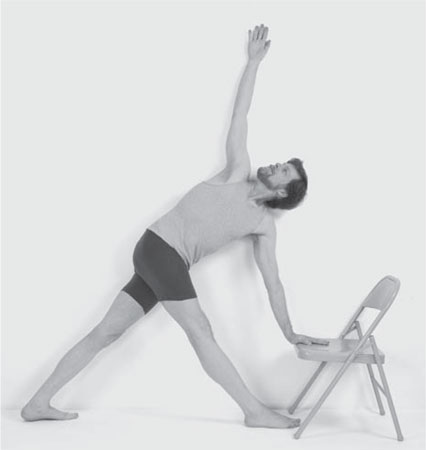
FIG. 6.11
I often ask my students to visualize the energy of their torsos as being like a tornado when they are in this pose. It starts out narrow at its root (your hips) and it becomes bigger and broader as it twists outward (your upper chest and arms). There's nothing wimpy about this poseâlet yourself fully express the power of your prana-filled vessel.
Bow Pose
Stretch and Strengthen | Dhanurasana
Now that you've warmed up your middle and upper back, check in with your lower back for a few breaths to make sure it's comfortable with the poses you've practiced so far in this chapter. If it is, you're ready to proceed into Bow Pose and Camel Pose, which are backbends that wake up and tone your entire spine. If your lower back feels tired or sore, practice the Locust Pose and Cobra Pose variations from chapters 3 and 4 until you feel confident about moving into deeper backbends.
Active Lying Down
Lie on your mat on your front body, or on a blanket for extra comfort, with your arms straight forward. You're not resting, though; press your hip bones and front groins down into the earth, and scoop your tailbone toward your pubic bone. Stretch your legs away from your waist, engage your abdominal core muscles, and elongate your trunk away from your waist. This is an active lying-down position that creates length in your lower back and helps support it in the backbend to come.
Half Bow Pose
Prop yourself up on your left forearm, bend your right knee, reach back with your right hand, and hold your foot. Press your shin and foot away from your body so your chest lifts (
fig. 6.12
). As it does, keep elongating your spine toward your front body, as if your spine could kiss your heart.
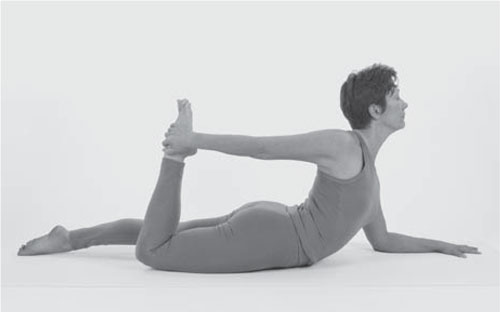
FIG. 6.12
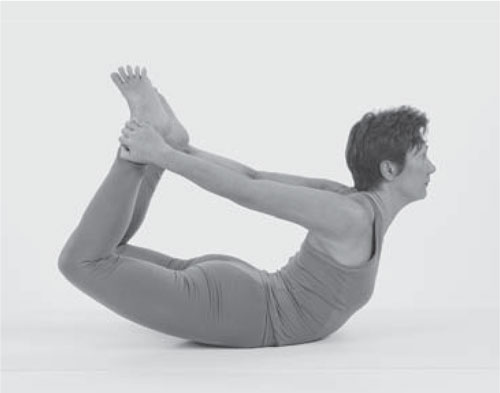
FIG. 6.13
Raise your chest only as much as your lower back comfortably allows. Hold for ten to fifteen seconds, then bring your right leg back to the floor. Place your head on your hands and rest for a few breaths, and repeat to the left.
Full Bow Pose
Once Half Bow Pose feels comfortable in your lower back, you're ready for the full pose. You'll start in step 1, “Active Lying Down” position. One at a time, bend your knees, reach back with your hands, and hold your feet (
fig. 6.13
). If you can't reach your feet, place a belt around your ankles and hold the belt with both hands. Draw your shoulder blades away from your ears and press them forward to broaden and support your chest.
Inhale strongly and deeply, and lift your chest and legs evenly up from the floor. Drop your chin slightly and draw your ears back, bringing your head and neck into alignment with your spine. Your eyes should gaze forward and feel soft, as if they were looking inward rather than outward. Then, if your neck is comfortable, lift your chin up, gazing softly upward. Feel your body rising up from the earth from the rootedness of your hips, your whole body curving into a smooth, curved cup shape; let your entire spine, from your tailbone to the nape of your neck, become a sacred vessel brimming with prana.
Hold Bow Pose for ten to fifteen seconds and then release your legs. Place your head on your hands, bend your knees, and lift your shins upward; gently sway them back and forth like windshield wipers for a few breaths. Rest in
Forward-Bending Hero's Pose
to give your spine a few moments to stretch and release any tightness.
Camel Pose
Stretch and Strengthen | Ushtrasana
If you're game for one more backbend, practice Camel Pose. It's basically the same shape in your body as Bow Pose, but it's done in a kneeling position. This creates a little more of a challenge for the lower back, since you're leaning back to move into the pose. To protect against lower back compression, you'll first practice Camel Pose with the support of a chair so that you learn its movements in a way that brings length into your lower back.
Supported Camel Pose
Kneel on your mat with a folded blanket underneath your knees and shins for extra comfort. Place a folding chair facing you, with the seat of the chair touching the front of your hip bones. Place your hands on the side edges of the seat of the chair. Bend your elbows toward your side ribs and come onto your fingertips. Scoop your tailbone in and up and create lift in your hips and length in your lower back; engage your abdominal core muscles to create firmness in your trunk.
Press your fingertips down and lift your chest up, as if you could lift yourself all the way to the sky. This is the key to creating space and comfort in your lower back. Draw your shoulder blades away from your ears, and press them forward to create “helping hands” of support for your upper chest. Now you are supported at both the base and top of the spine, by your tailbone and your shoulder blades, respectively. Feel your chest broaden and lift as you inhale, like a wellspring of rising energy, and feel a subtle inner lift through your spine as you exhale.
Elongate the back of your skull away from your shoulders, and if your neck is comfortable, take your head back and gaze up toward the sky (
fig. 6.14
), softening your eyes as you did in Bow Pose. If your neck is in discomfort, tuck your chin and gaze straight forward. To come out, release your hands, tuck your chin, and rest in Forward-Bending Hero's Pose. Check in with your lower back, and if it's comfortable, proceed into Full Camel Pose.
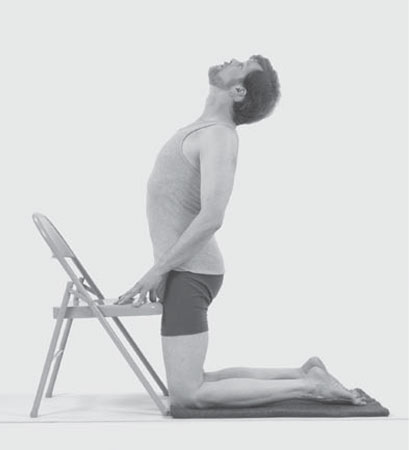
FIG. 6.14
Full Camel Pose
Kneel on your shins and place your hands on your sacral joints. Inhaling, re-create all the supportive actions and the lift in your chest that you found in Supported Camel Pose. Draw your hands down along the back of your hips, then one by one bring your hands to your heels. Look forward, or take your head back if your neck is comfortable, visualizing that your head is cradled by supportive, loving hands (
fig. 6.15
). Hold Camel Pose for ten to fifteen seconds. To come out, strongly press your thighs forward to lift your chest up and back to an upright position. Rest in Forward-Bending Hero's Pose.

FIG. 6.15
TIPS FOR A COMFORTABLE CAMEL POSE
Camel Pose is so strengthening for the lower back, yet sometimes it's a challenge to find a comfortable position. Here are a few suggestions to help lengthen your lumbar spine and create comfort in your lower back:
â¢Â  Place a chair behind your body, with the seat of the chair touching the back of your hips, and place your hands on the chair. As the pose becomes more comfortable with repeated practice, try walking your hands down the front legs of the chair.
â¢Â  Place a bolster across your calves and support your hands on it (
fig. 6.16
).
â¢Â  Place a belt under your shins and hold it with your arms firm and stretching; lift your chest up and out of the stability of your arms.
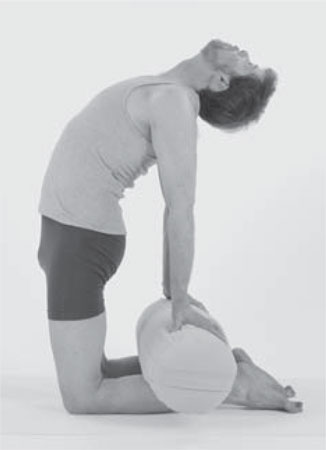
FIG. 6.16
Bharadvaja's Twist
Stretch | Bharadvajasana I
WHO WAS BHARADVAJA?
In yogic mythology, Bharadvaja was the father of Drona, the teacher of the warriors who fought in the wars described in India's famous epic, the Mahabharata.
37
One part of this epic, called the Bhagavad Gita, describes the inner journey of one warrior in particular, Arjuna, as he struggles with his prescribed role in life as a warrior when he is called to fight against his kinsmen. Arjuna's journey is a metaphor for the inner journey everyone takes in life; it is the search for one's true path. As you practice Bharadvaja's Twist, visualize the outer layers of your trunk releasing and opening so that you can see inside your heart and discover your own life path.
